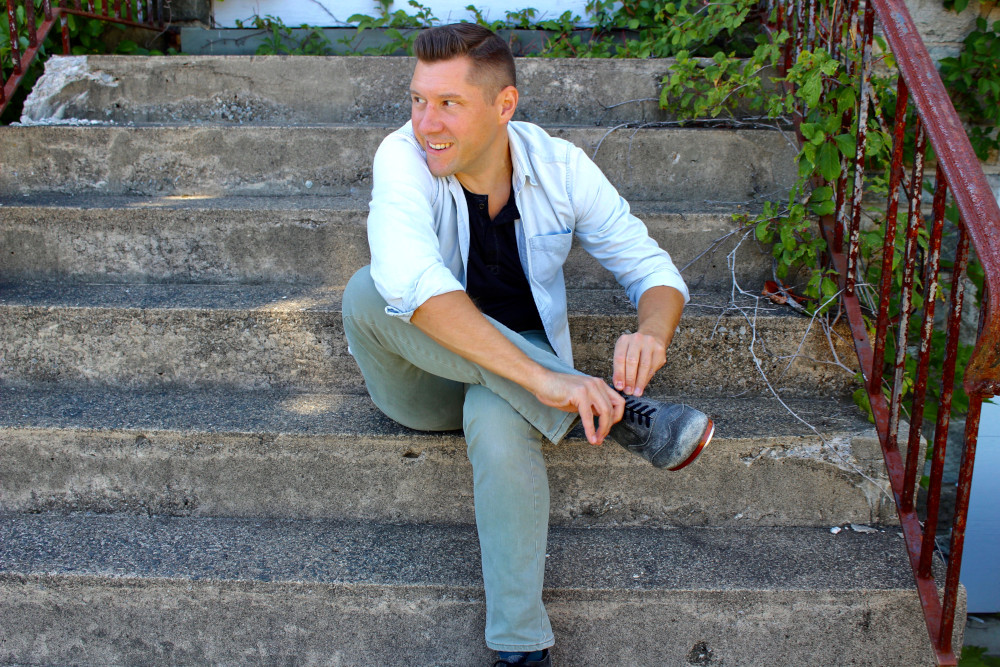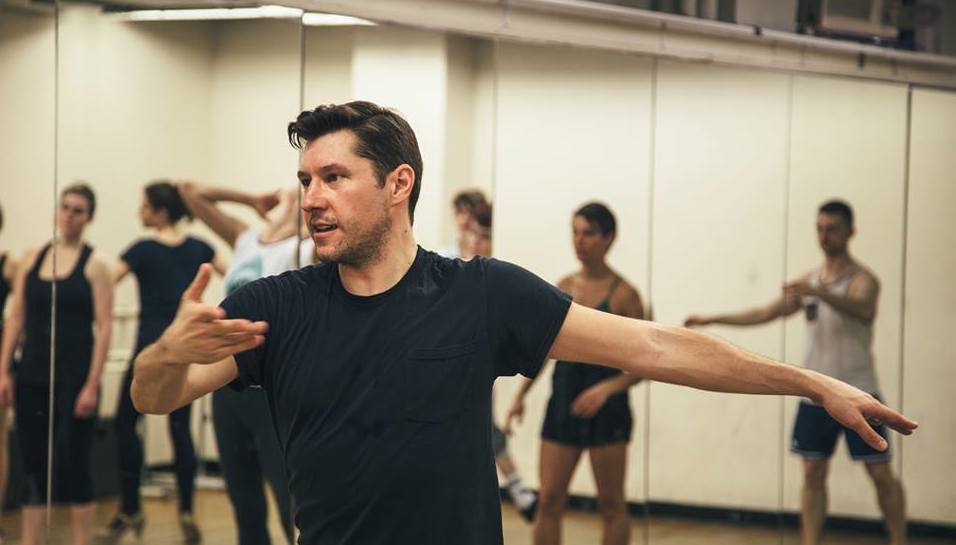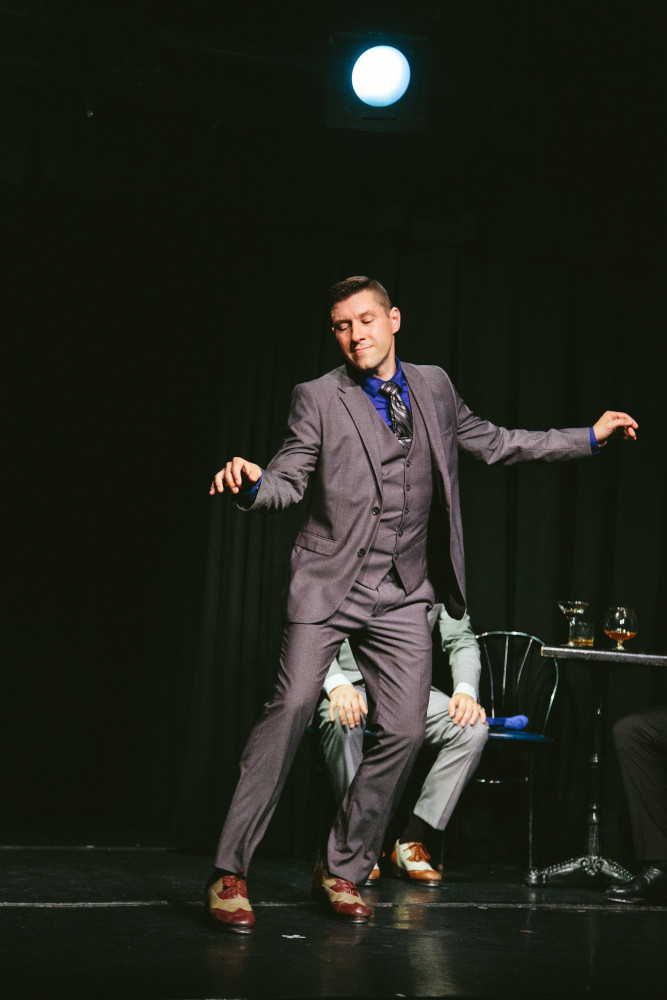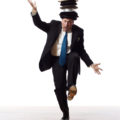Tutto Mondo’s interview with Justin Boccitto is now available in English. After Bob Boross, our reissuing for international readers is going back to Tap Dance.

1. Photo by courtesy of Justin Boccitto, JBIH Photography.
Justin Boccitto teaches tap and theatre dance at Broadway Dance Center and Marymount Manhattan College. His students have included Lady Gaga, Adam Chanler-Berat (Next to Normal, Peter and the Starcatcher), Sophia Anne Caruso (NBC’s The Sound of Music), Sean Fosse (Bob Fosse and Gwen Verdon‘s grandson), and Stanley Martin (Aladdin). He was also asked to teach Stephen Colbert how to tap dance and appeared as a coach on MTV’s MADE.
Justin served on guest faculty at The Juilliard School, The Pulse, Broadway Donation, Steps on Broadway, and Broadway Artists Alliance. He has conducted master classes throughout the country through his project Commond Ground, co-created with Germaine Salsberg.
Justin Boccitto, along with colleague Sol Bloch, is co-founder of the non-profit company, New Generation Theatre in Rockland County, producing musicals with area high school students while educating them in the craft of musical theatre.
As a director and choreographer Justin has worked with several companies and artists in theatre, television, and film. Credits include the Off-Broadway production of One Night With Fanny Brice, The Seven Little Foys, the NYMF production of What Do Critics Know?, and recently the short Cocaine, based on the play by Pendleton King.
Regional credits include Singin’ in the Rain at theMacHaydn Theatre (Chatham, NY), Sweeney Todd at the White Plains Performing Arts Center, and, for the Virginia Opera, Orpheus in the Underworld.
For his Hairspray production at the Lipscomb University in Nashville, Justin Boccitto received a Kennedy Center College Award for Best Director.
As a tap dancer he has performed, among other shows, at Tap City, Tap Extravaganza, The United Nations and Broadway to Brunswick.
In 2018 Justin Boccitto created the musical performance group, Phonic Evolution, a collaboration of composers, musicians, choreographers and dancers creating a new wave of rhythm and movement.
Justin is a member of Actor’s Equity Association and the Society of Directors and Choreographers.
Hi Justin Boccitto, thank you for the opportunity to take this interview. What means tap and jazz dancing for you and what do you love about it?
«For me, tap and jazz dance are the one thing that I do where I feel completely fulfilled by the experience. It doesn’t matter what kind of day I’m having, dance can always put me in a better mood. That was made very clear during the pandemic. The absence of dance really affected my day to day life. That being said, I know it will return.
Being in class and rehearsal is where I feel the most synchronized with other people. Similar to athletics, there is something about everyone doing the same thing and having the same goal that creates this “no I in TEAM” mentality. But with dance you are actually synchronized in body and mind. Everyone moving at the exact same time. I think dance is the only time we create the perfect harmony of mind, body, and spirit».

2. Photo by courtesy of Justin Boccitto, JBIH Photography.
Which was your favourite show to dance into during your career and why?
«Singin’ in the Rain was my favourite experience as a performer. I had been raised on that film and had a huge admiration for Gene Kelly as a dancer and choreographer. Getting to be in the show and play his role was an important learning moment for me. It taught me that even though Gene had originated the role of Don Lockwood that didn’t mean I couldn’t find new facets of the character that related more to me as a person. Once I allowed myself that it gave me the freedom to pay homage to Gene’s interpretation but also have the opportunity to make it my own».
Do you have any favourites dancers, performers, and musicals?
«Gene Kelly obviously. Gregory Hines is also a role model for me. The way he almost singlehandedly brought tap back to the mainstream in the 1980s was a very important moment in the history of the art dance.
Not a musical, but I remember Tap Dogs having a big impact on me as a young man. It was the first time I saw tap dancing as not just a form of entertainment, but as a storytelling tool. It also brought out the masculinity in the dance which was good for me at that time».
Let’s talk more about your work as a choreographer, do you have a specific choreographing process?
«The music is everything. I remember being hired for a new production of In The Heights in Brooklyn and I actually, slightly, knew Andy Blankenbuehler. So, I got the courage to send him an email. I shamefully admitted that I had never seen the original Broadway production of the show, which garnered him the Tony Award. Basically, I asked him if he thought I should go to Lincoln Center and see a video of his production before starting my process. And he gave me the best advice. He said, “Take as much time as you can to listen to the score over and over again. All the clues and direction you need to make your own version of the show lies in the music.” And that was it.
From that moment forward I approached every show by simply sitting down and studying the music, so I knew every accent, count and mood change like the back of my had. That has definitely helped me mature as a choreographer and storyteller. It’s a musical. Let the music guide you. I also started doing pre-production which has made putting together the show a much faster and efficient process. Allow the opportunity to be spontaneous in the rehearsal room but come in with confidence and a well-designed plan».

3. Photo by courtesy of Justin Boccitto, Live Like Mad.
Justin, you are also involved in the performing arts as a musician. In 2018 you have created Phonic Evolution, where you collaborate with other musicians, dancers, and choreographers focusing on rhythm and movement. Can you tell us something about this project and how tap dance had influenced it?
«This project came out of work I created at a self-produced event called The Choreographer’s Canvas in NYC. I was working with some fellow tap dancers on short, story driven vignettes where the dancers also played musical instruments while dancing. Not an easy task. My father is a musician and all my life I’ve played the guitar just as a hobby. But now my creative mind was sparked, and I thought, why don’t I expand on this idea and start writing my own music and create music videos incorporating musicians, dancers, and singers? So that’s what we did! Tap dancing definitely was at the core of the project, since we started with that dance form, but we did expand into other forms of dance».
From an American point of view, where musical theatre is going now? What is changing?
«From my perspective, I believe musical theatre always goes through these “growing pains”. When we look back at the history of Broadway, there are several shows that stand out as musicals that redefined the genre: Oklahoma, West Side Story, Hair, A Chorus Line, Hamilton, and the list goes one. I think you need these more progressive shows to help usher in the new generation of musical storytelling.
Audiences want to be entertained yes, but much like during the 1960s, I believe audiences, moving forward, are going to embrace more realism in the musical. I think we are going to see musicals that touch on subject matter that have a direct corelation with who we are as a society after going through a global pandemic. This will also affect the music in the Broadway musical. More modern scores will be written, thus bringing in more modern approaches to the way we dance in a musical. Hamilton is a perfect example of how choreography can really enhance the story but doesn’t have to be all about flash and tricks. It can be pedestrian and still effective».

4. Photo by courtesy of Justin Boccitto, James Jin Photography.
Justin, you and Germaine Salsberg are the founders of Common Ground Tap, a thriving community for tap dancers who, sometimes feel out of place, especially when it comes to the dividing lines between different styles: Broadway Tap, Hoofing, and Rhythm Tap. What is the meaning of Common Ground Tap? Which are the aims behind your community?
«Germaine and I had been speaking a lot about this gap in the tap community. Our students who were heavily involved in musical theatre really knew very little about the actual origins and history of tap dancing, especially the black history, and the rhythm tap dancers really knew very little about the musical theatre history. We also felt that tap dancers divided themselves into these two camps. So, by creating a class environment that culminated in a community hour afterwards, where the dancers could talk and share perspectives, we began to build an environment to help find Common Ground amongst these two camps. We also chose some amazing teachers who had their own very strong perspectives that didn’t label students into being one kind of tap dancers. A very “all inclusive” approach.
My analogy is always: Try all the ingredients that could go into a soup and then use the ones you like to make the best tasting soup for YOU».
During this pandemic, how do you cope with it in order to transform it into a new opportunity to re-think your work? For example, exploring the online capacity of reaching the entire globe.
«The online element has been challenging but oddly enough I was already doing it, to a degree, with some students out in Texas. This gave me time to learn how to teach via Zoom (a very difficult experience as I’m sure we can all agree). Also, by offering Common Ground classes online, and giving the post-class recording option, we suddenly found a whole new GLOBAL community. We have students taking our classes in Japan, London, Sweden, Italy…EVERYWHERE. You have to look at the positive results of the pandemic, otherwise the negative can overwhelm you and paralyze your innate desire to create and connect with others as an artist».
Have you ever considered teaching in Europe, and, of course, Italy once the pandemic is over?
«Absolutely and I only welcome any opportunity to do so!».

5. Photo by courtesy of Justin Boccitto, James Jin Photography.
As we know, Tap Dancing peculiarity is this trait d’union between dancing and music, what do you suggest to students/dancer who wants to develop their musicality and sense of rhythm? Any suggestions or advice for Italian Tap dancers?
«I would say the best thing that I started doing, that enhanced my musicality, was exploring other forms of music that I didn’t normally listen to, or that I didn’t normally equate with tap dancing. Expand your knowledge of music and also don’t just tap dance to music that is in the 4/4 time signature. Branch out of your comfort zone and challenge your mind».
Last but not least important, What are your plans for the future?
«I’ve learned to take my life one day at a time right now. So many unknowns for the future but I do plan to continue teaching through Common Ground, we are doing in-person classes in NYC starting in April. I also hope to travel more, both nationally and internationally, bringing workshops to groups all around the world. And I’m focusing on me as a person. Art is only as good as the human creating it. So, I want to be the best human first so my art can reflect that».
We thank Justin Boccitto for his time.
For more information about his work, you can visit his official webstite, his Instagram profile, and YouTube channel.
For more information about Common Ground Tap, you can visit the official website and the Instagram profile.
Leggi l’intervista in Italiano qui.
- Hair an american Tribal love rock musical - 8 Aprile 2025
- Heather Cornell: la tap dance è musica, teatro e danza - 21 Gennaio 2024
- Heather Cornell: tap dance is music, theatre, and dance - 21 Gennaio 2024




